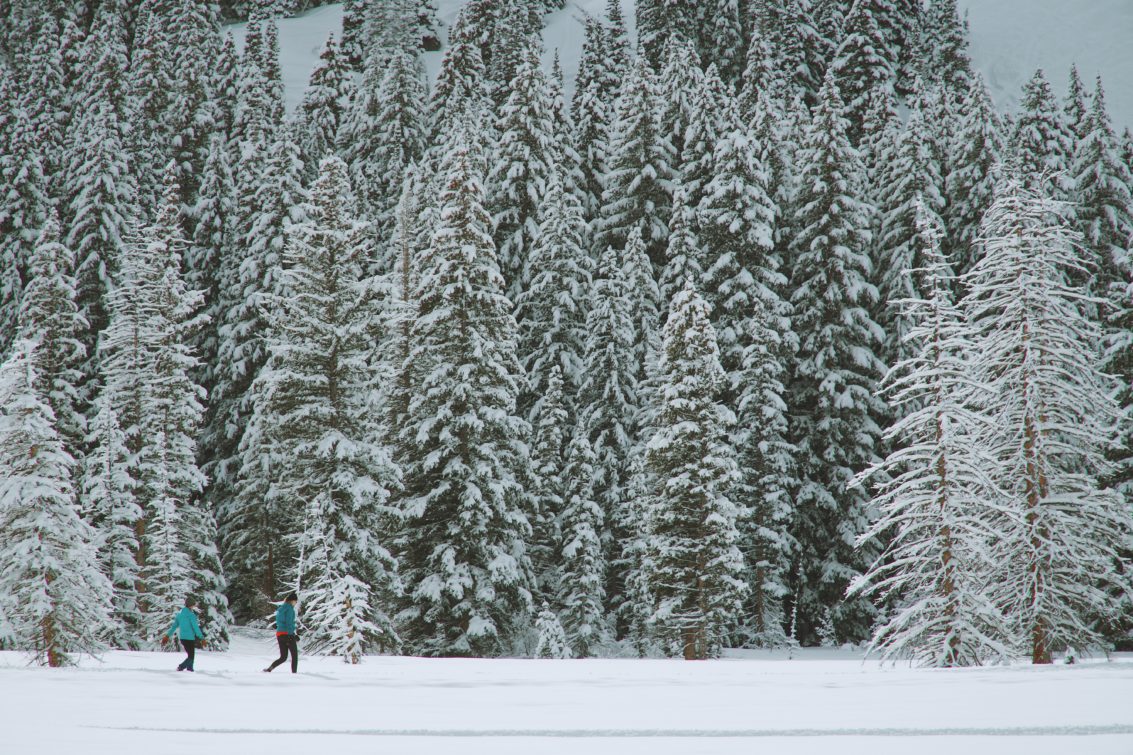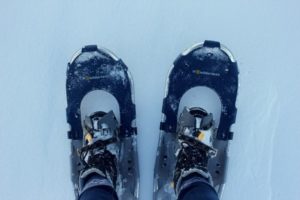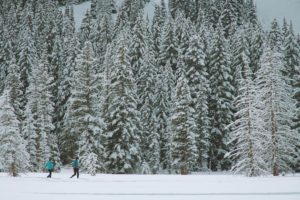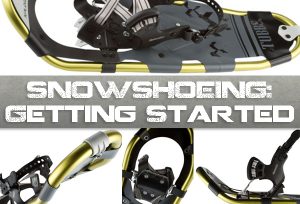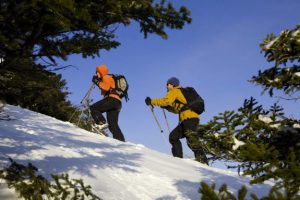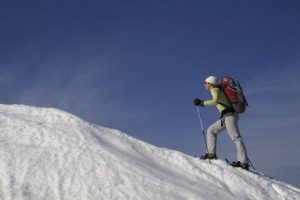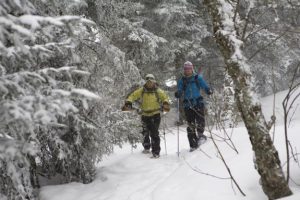Pretty soon the snow will be falling, and everything will be caked in a white blanket, that will have snowboarders and skiers alike making for the hills. Maybe you’re getting a little older or just don’t feel like emptying your wallet to pick up snowboarding or step onto a pair of skis. If you’re still searching for a winter hobby, it’s time to get into snowshoeing.
Why should I go snowshoeing?
Snowshoeing is a great winter sport for a wide array of people from old and young, rich or poor, male and female. The best thing about snowshoeing is that anyone can do it. It’s super easy to learn and will enable you to hike over wintry terrain like never before. On top of that, it’s much safer than other winter sports, making it great for kids and those getting older.
Snowshoeing is also great for your health. It helps improve cardiovascular health and, according to the SIA, can burn more than 45 percent more calories than walking or running at the same speed.
Perhaps even better is that it’s a relatively cheap sport to get into as opposed to snowboarding and skiing. You’ll need fewer pieces of equipment, and the items you will need are generally less expensive than other winter sports. So if you’ve got the time, you pretty much have everything you need to get started.
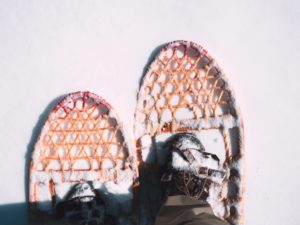
What’s in a snowshoe?
Snowshoes, like any other winter gear, can have a lot of tech built into them that allows the shoe to perform in a variety of ways. For our purposes here, we’ll keep it simple and cover the basic anatomy of a snowshoe.
- Decking: Aptly named, the decking is the material that gives the shoe it’s surface area. When you think of old snowshoes, it’s the part that stretches along the entire unit.
- Crampons: Crampons will give you traction on icy surfaces or hard pack. They run along the edge of the shoe and can vary from subtle traction to sharp teeth depending on use.
- Bindings: This is the part of the shoe where your boot straps in, giving you the reliable connection you need to keep moving.
- Frame: Frames are the portion that gives the shoe it’s shape and provide different degrees of float. They can be made of wood, plastic or aluminum, and the shape determines the float. An oval shape will float well in powder while tapered tails provide more natural gait.
- Pivot Point: Lastly, the pivot point is where the binding attaches to the frame.
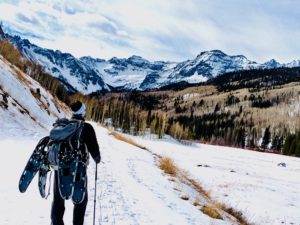
Getting suited up
Shoes
The obvious thing you’re going to need is a pair of snowshoes, so we’ll start there. There are three different types of snowshoes that are categorized somewhat differently across the industry. To keep it simple we’ll stick with the manufacturing standard.
- Flat terrain: These shoes are designed for more casual snowshoeing over clear trails and flat surfaces. They are perfect for families or those just looking to get outside in the winter.
- Rolling terrain: These shoes are made for rolling hills and steep slopes. They feature better treads and can be adjusted to allow better motion up or downhill. They are great for longer hikes off the beaten path.
- Mountain terrain: Great for icy and steep terrain. Features a better flotation device for use in powder. This class of snowshoes is great for more experienced hikers, typically those going out in the back-country.
There are also snowshoes available for racing or fitness, and these will generally feature a more sleek design and a tough build. Decide what type of terrain you’re going to encounter the most and what style of snowshoeing you’ll do and go from there. It’s always great to chat with your local retailer about what might be best for you. I would advise against buying used, simply for the reason that used gear may be damaged slightly which will greatly affect performance over time. Also, don’t forget poles!
Many ski resorts, Nordic outfitters and conservation areas will offer rentals, so if you want to give it a try before you buy, do it!
Attire
When you head out on your snowshoes, take three protective layers with you into the cold. Start with a base layer of wool or some other synthetic material. Wool and synthetics stay warm even when wet and dry quickly, which is super important when traversing through the snow and working up a sweat.
Over that, throw on an insulating layer such as polyester fleece. Polyester fleece is great for many of the same reasons as synthetics and wool. It keeps you warm even when wet or damp, and dries quickly should you get wet or start sweating.
Lastly, wear a waterproof shell jacket and pants to keep the wind off your back. Shell jackets typically have some kind of venting that will allow moisture from body heat to easily escape. This will keep you more comfortable and prevent freezing in or outside of the jacket or pants.
As for footwear, start with a pair of wool socks and avoid cotton. After that, you can bring whatever boots or shoes you feel most comfortable in, but there are a few features that will ensure you’re the most comfortable. Make sure that your boots or shoes are waterproof. Snow will melt around the heat of your boot and wet feet while snowshoeing sucks. Leather hiking boots are an excellent choice for snowshoeing. I prefer a higher cut boot and gaiters to prevent snow from falling into the boot.
Other gear
There are a of couple small items that are important to remember when you head out.
First things first, never forget to bring water with you. When you’re out in the cold, you don’t always feel thirsty like your body might feel during a hot summer day. But you can be sure that you’re using just as much water to keep going. Take a water bottle with you in a backpack or a super convenient hydration pack to stay hydrated.
Next, I would recommend taking a compass and map if you are going hiking in the back-country. If you lose your way and you’re out of cell range, the old school method will help get you back to civilization.
Similarly, for back-country hikers, consider bringing an avalanche beacon. Avalanches are a very real threat to back-country snowshoers, and a beacon could save your life should you get caught in one.
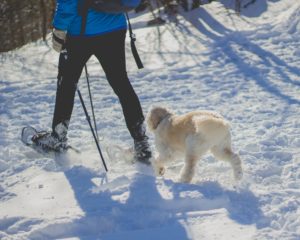
Where should I start?
The best thing about snowshoeing is that you can really do it anywhere where there is snow on the ground, but there are some places that make more sense than others.
If you’re new to the sport, the best place will probably be some kind of state trail that is unkempt and open during the winter. The terrain will be mostly flat, and you can easily trek out for some distance then turn around and come back. Parks or snow-covered golf-courses are also a place to get your feet wet (not literally though).
Next, most ski resorts allow snowshoeing on their grounds. This is a great place to try out some more difficult terrain and build endurance for longer hikes. Just remember that skiers get the right of way because it’s easier for you to stop and step off the trail than it is for them. Be respectful!
Finally, when you’re feeling confident about your skills, go for a long hike in a national park or forest. These lands will be mostly untouched and feature incredible views and a deep quiet that is perfect for a hike. Here is a list of Minnesota State Parks that offer snowshoeing. If you’re feeling really bold, snowshoe out to a beautiful spot and camp for a couple days. Check out this blog on winter camping to learn more!
As always, remember to plan ahead. Know what to expect from the weather and know a thing or two about that land you plan on hiking. There are all kinds of surprises out there in nature, and you should be prepared to deal with them. Most importantly, make sure to have fun!
